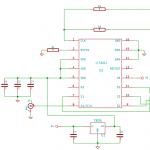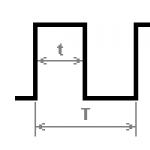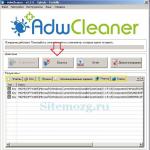Windows 8 System Restore may be required if critical errors in PC operation. So that the user does not have to completely reinstall the OS, special tools are provided that allow you to restore your computer even without deleting files or changing general parameters systems. In this article you will learn how to start restoring a computer or laptop on Win 8 in different ways.
Below we consider two scenarios for the development of events: with a working operating system and with a faulty one. In the first case, you can perform recovery from the Windows 8 interface without a disk or flash drive, and in the second you will need bootable media for copying system files. All methods are presented below:
- rollback from a restore point;
- using Refresh your PC;
- reset to factory settings on laptop;
- recovery using boot disk or flash drives.
Let's consider each of the methods in detail. All instructions are fully working and suitable for any Windows builds 8 32/64 Bit.
System restore point
This method allows you to roll back the OS to a certain state. You must do the following:
- Open File Explorer using the icon on the taskbar.

- In the left directory, find the item “This computer” and click on it right click mouse to select “Properties” from the menu.

- In the window that opens, click on the “System Protection” button.

- In the selected tab, click on the “Restore” button.

- On the first screen, click on “Next”.

- From the list, select a checkpoint according to the date when the computer was stable and working. Click "Next".

- To start the procedure, click the “Finish” button.

Now you know how to use a checkpoint to rollback the state of the OS.
Creating a checkpoint
If you don't have it configured automatic creation checkpoints, you can do this manually. This option will be useful if problems arise with the OS in the future:
- Open the Properties window again and click on System Protection.

- Next, click on the “Create” button marked in the screenshot.

- Enter a name and click "Create".

- Wait until the procedure is completed. After it, the current OS configuration will be saved as a checkpoint. You can easily restore this state if Windows malfunctions 8 using the instructions above.

Rollback via Options
Windows 8 debuted the Refresh Your PC tool. With its help, the user can roll back the OS state to the required state. You can save applications and settings, return your PC to factory settings, completely reinstall the system, or launch a safe environment and perform the necessary actions through it.
First you need to open “Computer Settings”:
- Right-click on the Start icon and select Find.

- IN search bar Search for "PC Settings" and open the appropriate application.

- In the list of sections, select "Update and Recovery".

- Go to the “Recovery” subsection. Here are the tools to help you get back initial state OS or start safe mode.

The first option (1) allows you to restore factory defaults. Windows settings 8 without losing personal files, music, photos, etc. Using the second item (2), you can call up a menu to completely reinstall the OS and return it to the factory preset settings. This will delete all personal files and installed applications. By clicking on the button in the third paragraph (3), you can call up the safe environment and continue settings through it. The first two options allow you to roll back the system from the Windows 8 interface.
It’s worth taking a closer look at the safe environment, since advanced functionality awaits you there.

Click on the “Restart now” button and wait - on the screen you will see a menu launch with a choice of action. Click on "Diagnostics".

As you can see, here you can perform all the same operations as in Windows interface 8. However, the diagnostic menu can be useful if the OS does not boot. Click on the “Advanced options” button to access advanced functionality. With it you can:
- roll back the OS to a checkpoint;
- use wim image for recovery;
- roll back the system via the command line.

Let's consider all the possibilities in more detail. We dealt with the first point above - the procedure is no different from doing it in running Windows 8.
By clicking on “Restore system image”, you launch a program to automatically unpack a pre-created wim archive. It should contain the entire OS with personal settings and programs. You can connect a disk or flash drive to your computer to unpack a third-party wim image. This way you will get a complete system.

"Command Prompt" allows you to start the rollback procedure using simple commands. Click on the appropriate button to launch the application. Now enter the command “rstrui.exe” and press Enter to run. After this, you will have access to the PC recovery menu via checkpoint.

You can launch this menu through bootable media if the installed OS does not work correctly and does not start. Let's consider this situation.
Performing the procedure using a flash drive
Performing the procedure this way will require some preparation. First, you need to create bootable media. To do this, you need to visit the official Microsoft website, where the Windows 8 web installer is located and download it to another computer. The bootloader will download the OS files and create boot drive automatically.

Secondly, you need to make settings through the BIOS. To do this, when starting the PC, press the button responsible for entering the BIOS menu (it is indicated on the initial computer startup screen). Go to the "Boot" menu and install bootable USB flash drive first place in boot priority. To save the settings, press F10 and restart your PC again.

Now when you turn it on you will see the installer menu. Here you will find the option to uninstall, reinstall the system, format hard drive. The creators also included the recovery function in a separate menu:
- When downloading the application, select your language and click Next.

- On the second screen, click on the marked button.

- Open the Diagnostics menu.

- Using "Restore" will open the tool to roll back to a checkpoint. The Reset button launches a tool to return the OS to its factory state. You are already familiar with the contents of the “Advanced Settings” menu.

- Select the desired item and start the procedure.
Rollback on a laptop with a pre-installed operating system
Laptop manufacturers that sell devices with pre-installed software provide the ability to rollback using proprietary utilities and funds. Part of the hard drive space is allocated for recovery, so you can start the process of returning your PC to its original settings in a couple of steps.
This applies to Asus laptops, Lenovo, Acer, HP and many others. Let's look at the procedure using Acer as an example Iconia tab w5100. By default, this company uses the keyboard shortcut Alt + F10, which must be pressed on the initial boot screen with the Acer logo.
You will see the "Acer eRecovery Management" menu. Select the marked item.

After this, wait until the procedure is completed. During the process, the laptop may reboot several times. The only way to cancel the recovery process is to restart the PC. After the rollback is complete, you will receive the device with factory settings.
The names of the utilities and how to access them differ depending on the laptop manufacturer, but according to this example you can easily restore Windows 8 on any device.
Conclusion
Using the methods described, you can return the working or original Windows status 8 in almost any situation. Use checkpoints to restore your computer to its previous state. The Refresh Your PC functionality is useful when restoring your PC to factory settings. A safe environment is useful if Windows 8 does not start - the necessary tools can be opened via a bootable USB flash drive.
Video
Below you can watch a training video that clearly shows all the steps from this article. Together with the video instructions, you will be able to figure out the difficulties and restore your computer without outside help.
Windows 8 is the penultimate operating system from the famous Microsoft company. Considered innovative, appeared with a large number new settings and was immediately loved by users. But it didn’t take root completely; according to statistics, most users remained on Windows 7. Nevertheless, a large number of people use Windows 8 and, like everyone else, sometimes problems arise.
How to restore factory settings in Windows 8?
Many G8 users are wondering how to return to factory settings? There could be many reasons for this. Often a person changed something, forgot how he did it and now cannot use the system normally. So he wants to just reset everything to standard settings.
Instructions:
- First you need to use the panel located on the right. The easiest way is to press the key with the Windows + C icon;
- Now we need to select “Change computer settings”;
- Next, look for the general section and click on “Delete all data and reinstall Windows”;

- Be sure to read the information that appears. It will tell you what will happen to your computer when you use factory settings;

- Click next and select hard drive on which Windows is installed;



- Ready!
If you have Win 8, restoring the system to factory settings can be done very quickly. No need to download any programs or utilities. Just follow the instructions above and then restart your computer. After turning on, Windows will be as it was from the very beginning, clean and with factory settings. There are several other methods, but they all take more time and may seem more complicated to the average user. So no need to search long paths, just use these instructions.
Returning the computer to its original state was not an easy or quick task. But now, with the help of new features, this can be done in minutes. I can’t even believe it, right? However, this is one of the better opportunities Windows 8.
At work, I have to constantly test various programs, so my computer needs regular maintenance. Recently I decided to spring clean both of my machines: the HP system unit and the Samsung ultrabook. The day before, I had just visited Microsoft's Redmond office, was impressed by what I saw and was determined to try the reset function on my ultrabook.
It turned out that, in fact, recovery is now much easier and faster than before.
To return previous versions of Windows to their original state, there are only two ways: you can use recovery tools from the computer manufacturer - be it a special partition on the hard drive or a rescue CD, or you can completely reset the operating system from the installation Windows disk– although in this case, re-installation of the drivers is additionally required.
Manufacturers usually love to stuff computers with a variety of junk utilities. There are exceptions - Lenovo ThinkPad, for example, and, of course, Microsoft Signature - but one way or another, I prefer to reinstall the system from scratch every time to guarantee a clean Windows version without unnecessary garbage. However, in Windows 8, new options have been introduced to return the computer to its original state, which are informally called “one-button recovery.”
Such a term in the most operating system not found anywhere - this is an internal designation for two Windows functions 8: " Recover PC without deleting files"(Refresh your PC without affecting your files) and returning the computer to its original state, also known as " Removing all data and reinstalling Windows» (Remove everything and reinstall Windows). What to choose depends on your specific needs.
Both functions work in a similar way: they quickly uninstall and reinstall Windows 8, returning the original configuration. But PC Recovery additionally saves Metro applications, personalization settings and user files to a temporary folder, and then copies them to the reinstalled Windows.
The "initial configuration" depends on the computer. If you installed Windows 8 yourself, the system will be restored to its original state, as Microsoft intended it to be. If Windows 8 was pre-installed on a branded computer, the initial configuration will include the necessary drivers and, unfortunately, garbage from the manufacturer.
For some reason, I prefer to use the “Reset my PC” function rather than “PC Restore”. Actually, the solution is not the most reasonable, because every time I have to restore all my files again through SkyDrive. But one way or another, the process starts in the same way in both cases: from the Metro interface “PC Settings” or from the Control Panel ( Control Panel). And if the system does not boot, you can use the recovery environment, which is available both from the Windows 8 installation disk and from the recovery disk (for details, read the article “”). Since it's easiest to launch recovery from Metro, let's look at this option.
Options for restoring and resetting your computer are presented in the PC Settings panel under General, towards the end of the list.

When you select the "Repair PC" option, a message will appear explaining the upcoming procedure. Confirm execution, and Windows will be reinstalled, preserving all user files, personalization settings and Metro applications.

Everything happens in a matter of minutes, although if the manufacturer has crammed its own applications into the system, the process may take a little longer. On my Ultrabook, which I first restored to its original state as described below, the recovery procedure took about 10 minutes, including the recovery of approximately 8 GB of data.
When you select the “Remove all data and reinstall Windows” option, the explanation of the procedure is much shorter, because it itself is simpler: the system is simply reinstalled from scratch.

However, on the second page of the wizard you will also be asked if you want to completely erase the disk.

If you just need to return the system to its original state for personal use, it is better to limit yourself to deleting user files (Just remove my files), because it is much faster. Complete cleaning disk (Fully clean the drive) is needed if the computer is going to be given away or sold, so that the new owner will not be able to restore your personal data using special utilities. The cleaning process takes quite a lot of time, but then the computer can be transferred to another user with peace of mind.
If you do not use cleaning, the process of returning to its original state is even faster than restoration. On my ultrabook it only took 7 minutes.
However, it is worth considering that none of the new recovery methods saves drivers, since Windows 8 is reinstalled in any case. Therefore, if the manufacturer did not include drivers in the recovery process, they will have to be installed manually. Nothing has changed here: first update Windows, and if some drivers are missing, download the ones you need from the manufacturer’s website or via special application(I have this on my Samsung ultrabook).
If you need to return or sell your laptop, a computer with Windows 8, and it has programs, games installed, and a lot of your photos, videos and music are stored on it, then you will definitely have to reset the system settings to factory settings. Or, for example, if your PC starts to malfunction, then this option will do too. In this article you will learn how to do this.
This instruction applies to both Windows 8 and Windows 8.1. There is a slight difference in the reset process on these systems, which I will discuss.
Read on our website:
So, move your mouse pointer to the right corner of the screen, thereby bringing up the side pop-up panel. We are interested in the “Parameters” item. Click on it.

Here are the reset instructions Windows settings 8 and Windows 8.1 are different. For Windows 8, select “General” from the list of options; for Windows 8.1, select “Update and Recovery.”
Then everything is identical for both versions of the operating system. There are two options for resetting your settings: restoring your computer without deleting files, or deleting all data and reinstalling Windows. The first one is suitable for those who have experienced system malfunctions and just need to return all settings to factory settings, leaving all the files. The second is a full reset of both the system and data.

Select the one you need and click “Start”.

You may receive a message asking you to paste installation disk. Then just insert it into the drive.
Then just follow the directions. If you chose to restore your computer without deleting files, then at the end your PC will reboot and all user files saved in the profile (“My Documents”, “My Videos”, “My Images”, etc.), as well as Metro applications installed from the Microsoft Store will remain untouched. A file with a list of deleted programs will be created on the desktop.
If you choose to delete all data and reinstalling Windows, then in this case you will receive a laptop or computer in the same condition as when you first started the system.
Windows 10 includes a “restart your PC” option that lets you quickly restore Windows to its factory default configuration. This option is much faster and more convenient than reinstalling Windows from scratch or using the recovery partition created by your PC manufacturer. Windows 8 had separate options for “Update PC” and “Reset PC settings”. Updates keep all your files and settings, but set your PC to default settings and remove desktop apps. Reset deletes everything, including your files, just like Windows resintall does from scratch.
In Windows 10, things are a little simpler. The only option is “Reset your PC,” but during the process, you will be able to choose whether to keep your personal files or not.
How to reset your computer to its original state
If you choose to use the “Reset this PC” feature, Windows will be completely reset to its factory default settings. If you purchased a computer with Windows 10 already installed, your computer will be in the same condition with which you purchased it. All manufacturer installed software and drivers that came with the PC will be reinstalled. If you installed Windows 10 yourself, it will be a pure Windows 10 OS without any additional programs.
You have a choice - you can keep your personal files or delete them completely. But, all your installed programs and settings. This will ensure that you have a fresh system. Resetting your computer should resolve any issues related to third party software, corruption file system, system settings changes, or malware.
If the purchased computer has a pre-installed operating system Windows system You may also see a third option, “restore factory settings”. This will restore the original version that came with your PC, so if your PC came with Windows 8 and you upgrade to Windows 10, it will be reset back to Windows 8.
This process is very similar to, but more convenient than, reinstalling Windows from scratch or using the manufacturer-provided recovery partition.
Microsoft has explained what actually happens when you reset your computer and delete everything:
The computer boots into Wednesday Windows recovery, in Windows Recovery Environment
The recovery environment erases and formats again Windows partitions before installing a new one copy of Windows.
The computer will reboot into a new copy of Windows.
When you choose to save your files, the same steps follow. But before deleting the partition, Windows Recovery Environment rescans the hard drive for your files and personal settings. He puts them aside, installs a new copy of Windows, and puts them back where he found them.
How to reset your computer in Windows
To reset your PC to factory settings in Windows 10, simply open the Settings app, and go to Update & Security > Recovery. Click the “start” key in the “reset your computer” section.
In Windows 8, go to Change PC Settings > Update & Recovery > Recovery to find the equivalent of the “update your PC” and “reset your PC” options.
You can choose to either “Keep My Files” or “Delete All”. If you select “Keep My Files”, Windows will be reset to its default state, removing installed applications and settings, but will save your personal files. If you choose “delete everything,” Windows will erase everything, including your personal files.
If you just want a fresh Windows system, select “Keep My Files” to restore Windows without deleting your personal files. You should use the “remove everything” option when you sell the computer or give it to someone else, so it would be better to erase your personal data and install the PC in factory condition default. Either way it's a good idea to have backups your important files before using this feature.
In Windows 8, the option to keep My Files was called “update your PC,” and the option to “remove everything” was called “reset your PC.” For Windows 10, these things are simplified, this process is called “restarting the computer” and asks the question - what do you want to do with your files.
If you decide to delete everything, then Windows will ask if you want to “clean up the drives too.” Select “delete files and clean up disk” and Windows will copy data to the disk to deleted files could not be restored. This is ideal to use when you are selling or giving away your computer (or hard drive).
How to reset your computer to boot menu
If your Windows PC won't boot, you can reset it from the boot options menu. We've covered several ways to access this menu. But, the same menu will appear automatically if Windows cannot boot.
Select Troubleshoot > Reset PC to reset your PC through the menu.
How to get a fresh Windows 10 operating system without being locked
The “Reset this PC” option is convenient, but there is one big problem with this: if your PC manufacturer installed many unnecessary programs that you don’t want to install, then resetting the computer to its original state will return all this junk back.
Luckily, with Windows 10 Upgrade, there is an easy way to get the latest Windows 10 from Microsoft. Just click on “learn how to get started with clean install Windows” - link to settings > update and security > recovery screen.
“PC fresh start” download tool Windows image 10 directly from Microsoft and will install it on your system, giving you a fresh system from Microsoft with none of the software that was installed at the factory. Hardware drivers should be downloaded automatically from the center Windows updates after you're done. If you need a hardware driver or program that isn't automatically installed from Windows Update, you can find it on your PC manufacturer's website.
Windows 8 allows you to create custom update images. Whenever you update or reset your PC, it will use your custom images instead of the default one. For example, you can remove viruses that came with your PC, install important software, or change system settings and then create a Refresh image with the current system state. But, this option is missing in Windows 10, but at least in Windows 8 it was a nice consolation prize.




